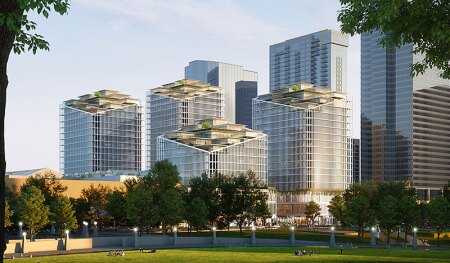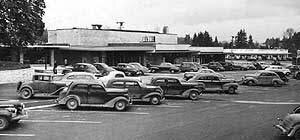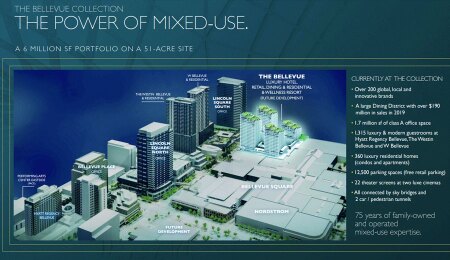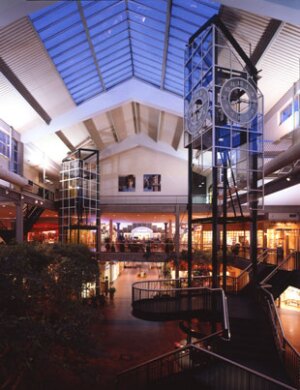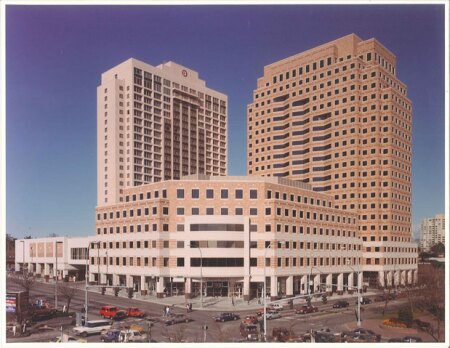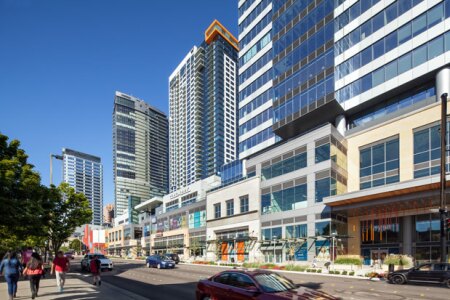Following the example of one of America’s premier shopping centers after 75 years.
Southdale shopping center’s indoor covered mall opened in 1956 in Edina, Minnesota. The project set the template for almost 2,000 malls across the United States, and many more around the world.
Viennese architect Victor Gruen said that he pictured Southdale as an integral part of a much bigger development, surrounded by homes, offices, schools, and community centers. He envisaged the re-creation of a city center. He wanted to avoid what he viewed as the feelings of unplanned urban districts. His dream was never fulfilled, however, as accelerated depreciation made it so profitable to build suburban malls that there was no need to integrate them into a bigger urban context.
For decades, it seemed every American town wanted a mall and for many that appetite was satisfied. A formula for how to build a successful mall quickly emerged and woe betide if you did not follow the formula. All the action was on the inside. Malls outdid each other with the secular cathedral approach. Little attempt was made to harmonize with the surrounding community with its ubiquitous sea of parking framed by institutional-looking structures. So little street appeal existed.
In the relentless pursuit of generating higher income, the tenant mix of the mall changed significantly. New freestanding retail concepts already had emerged: discount department stores, warehouse clubs, and category-killer box stores. No longer was the mall a one-stop shopping venue for the entire family but mostly associated with full-price fashion stores. For a time, they were very successful and became victims of their own success.
The growth of e-commerce and the uncertainties of COVID-19 have accelerated the decline that has occurred over the last two decades. Southdale itself has benefited from adding apartments and restaurants as it lost anchor tenants like J.C. Penny.
A Town Center
Much is written today about the plight of malls with many sensationalist headlines. The solution is not to try to continue operating a single-purpose, single-use shopping center, but rather boldly rounding out its appeal as a true town center with associated mixed-use elements. If you get it right, it becomes the center of a community.
In so doing, you have created a multiplicity of reasons to visit the center, not just the single pursuit of shopping—entertainment, leisure, and recreation have become indelible adjuncts to the shopping experience—then overlay this with a residential, office, hotel and you have places that are populated every day of the year.
In theory, this sounds so obvious and logical, that good retail can be the logical catalyst for mixed-use development. Why has there been so much resistance?
A primary influence on key decision making is that real estate is a subset of many different sectors— residential, office, hospitality, industrial, institutional, retail—and that separate expertise/discipline is required for each. Just because you may be a successful residential developer with your own set of principles, rules of thumb, does not mean that success translates into retail or vice versa—so the apprehension/reticence/intransigence becomes palpable.
The fact remains that many of these malls were built on the build-it-they-will-come premise a and people did come as they became an anchor for new communities. Consumers were confident. Household income was growing. They would buy on impulse at stores like Sharper Image and Brookstone. But now malls were under siege. The time had come to rethink their future.
Do they fritter away and await till a higher and better use emerges or do they take charge and harness their remaining strengths into a new paradigm? For most in this predicament, mixed use development can be the solution and savior.
A Poignant Example
How is it that one of the industry’s first centers, first opened in 1946 and still under the same family ownership, is now one of the best? How have they been able to achieve such a feat?
Bellevue Square in Bellevue, Washington, is an example of a living organic center for the community it serves.
In the competitive world of real estate, Bellevue Square stands as a pillar of imaginative, inspiring, forward-thinking planning and mixed-use development—a tour de force in every sense—and a standard by which others will surely follow and be judged.
Professor Richard Peiser of Harvard University’s Graduate School of Design has interviewed the present patriarch, Kemper Freeman Jr., on numerous occasions. Freeman credits Dr. Sol Rabin of Crystal Asset Management in 1986 for the great epiphany about mixed use, “Great retail is a catalyst for all other forms of real estate.”
The center has grown from 40,000 square feet (3,716 sq m) in 1946 on 10 acres (4.04 hectares). In the 1980s, corporate offices were attracted to the area giving rise to demand for hotels. In response, so began Bellevue Square’s initial foray into mixed use with the development of the 20-story Bank of America office tower and adjacent 367-room Hyatt Regency, both opening in 1989.
In the 1990s, the City of Bellevue was experiencing major growth and an international development team planned a large-scale project next door, hoping to capitalize on the draw of Bellevue Square itself. When this development faltered, it was logical for the owners of Bellevue Square to take it over. This was achieved with great sensitivity. Clearly, this 3 million square foot (27,8709 sq m) addition of Lincoln Square further contributed to making Bellevue Square the cornerstone of the City of Bellevue.
By keeping abreast of forever changing consumer demands, they have created one of the largest and most successful developments in the country. On a single site of 51 acres, you can:
- Shop in one of America’s 10 best trophy malls
- Stay in one of three 4-star hotels with a 5-star hotel coming
- Live in one of 500 condominium units
- Work in one of five office towers
- Attend a megaplex
- Play miniature golf
- Dine in one of 80 sit-down restaurants
- Visit a museum
Is this not the poster child and snapshot of modern living, working, playing, shopping today? What a vote for mixed-use development with uses all inextricably linked to create this seamless experience. No surprise that it’s now marketed as an “urban resort.” An estimated 30 million people visit Bellevue Square annually, making it one of the busiest entities in the country.
In essence, Bellevue Square is living testimony to the benefits of mixed use by creating as a single destination that has a multiplicity of reasons to visit and where the raison d’être of each use is enhanced immeasurably through synergy.
Is it also any wonder when Microsoft canvassed their 180,000 office workers in 650 buildings around the world, what type of environment they would prefer, their universal preference was unashamedly in favor of the Bellevue Square?
Peiser observes that a huge part of Freeman’s success is that “unlike almost every other shopping center developer, Kemper has focused all of his energy in one location. He lives in one of the buildings he built. He has endowed the Art Museum and soon the Performing Arts Theater. He is a pillar of the local community, and he walks through the shopping center daily where he knows and greets almost every tenant by their first name.”
“What also is so dramatic are the separate values created for the mixed-use elements that have benefited immeasurably from synergy resulting in such accretive increases in valuations,” says Richard Gollis, principal of the Concord Group. “Whether it’s office rents, hotel rates, apartment rents, and condominium valuations, they all rank as the highest in the city—a direct result of the quality of the retail.”
From the outset, the Freeman family maintained if they made a profit, much of it would be dedicated to making the town of Bellevue a better place, particularly in education and healthcare. This rare, holistic approach with overtones of “If we look after you, you will look after us” has resulted in windfall dividends. With a reputation of having amongst the best schools and medical systems in the country, is it any wonder many of the executives from the head offices of Fortune 500 companies like Microsoft, Amazon, Nordstrom, Starbucks, and Costco choose to live in the Bellevue catchment?
In an era where concepts could be quickly commoditized and monetized, Bellevue Square stands as a pillar of specialization: selecting a site, letting it grow and prosper, from its inner bull’s eye adding more fertilizer to sprout complementary uses, marveling how it becomes the city within a city, and reveling in the capital appreciation.Bellevue Square clearly has solved the dilemma that single-use malls face. As such, it can serve as a blueprint of not only giving malls a new lease on life but can also facilitate a more holistic approach to town center planning and resulting synergy as part of the expanded cultural and social realm. No doubt, Victor Gruen finally would be smiling with such a poignant example personifying his dream.
IAN F. THOMAS is chairman of Thomas Consultants, a firm which specializes in the planning of large-scale retail projects around the world where it has worked in more than 70 countries.
Other Recent Urban Redevelopment Features:

